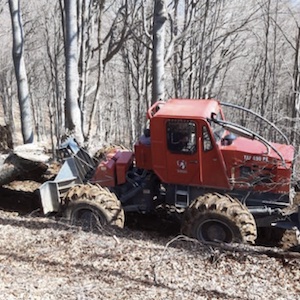Productivity analysis and costs of wheel cable skidder during salvage logging in European beech stand

All claims expressed in this article are solely those of the authors and do not necessarily represent those of their affiliated organizations, or those of the publisher, the editors and the reviewers. Any product that may be evaluated in this article or claim that may be made by its manufacturer is not guaranteed or endorsed by the publisher.
Authors
Salvage logging is increasing in Central Europe because of the growth of severe meteorological events, and timber harvesting in these conditions is challenging in terms of both productivity performances and safety of the operations. In recent years, with the increase of natural calamities, several researchers studied machinery productivity performances regarding salvage logging carried out by ground-based systems. In fact, a common post-disturbance management approach is salvage logging which consists of the widespread removal of damaged trees. In this research, system productivity and the cost of salvage logging are analysed in European beech stands affected by wet snow. The accretion of heavy wet snow poses the greatest risk to forests in the Northern Hemisphere. This type of snow attaches more effectively to tree crowns and branches when temperatures are close to freezing at the time of precipitation. As a result, trees may break or bend and may be uprooted when the soil is unfrozen. This study has been implemented to evaluate the productivity and cost-effectiveness of extraction in salvage logging deployed with a skidder in beech stands affected by two different types of wet snow damage. The results show that the productivity of the four-wheel-drive cable skidder, despite operating in salvage cutting with a removal intensity of 10%, is 14.73 m3·SMH–1, similar to skidder performances in ‘ordinary’ cuttings. Skidder’s productive time was 86% of the scheduled time, whereas the delays were due to organisational reasons, mechanical delays, and adverse weather conditions. The mean travel speed of the cable skidder obtained in this study is close to the results obtained from other studies on similar machines. The costs per unit are lower than effective cost consumptions for the other cable skidders and agricultural tractors, adapted for skidding operated in hardwood salvage logging. Therefore, under the given conditions, the operation of the fourwheel-drive cable skidder is viable from a silvicultural, technical, and economic point of view in the salvage operation logging.
How to Cite

This work is licensed under a Creative Commons Attribution-NonCommercial 4.0 International License.














